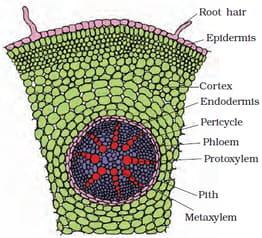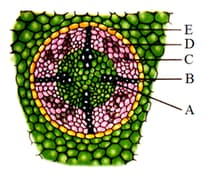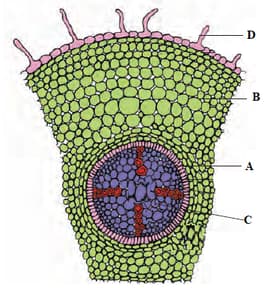Select the wrong statement.
Important Questions on Morphology and Modifications
Read the following statements about the vascular bundles:
(a) In roots, xylem and phloem in a vascular bundle are arranged in an alternate manner along the different radii.
(b) Conjoint closed vascular bundles do not possess cambium.
(c) In open vascular bundles, cambium is present in between xylem and phloem.
(d) The vascular bundles of dicotyledonous stem possess endarch protoxylem.
(e) In monocotyledonous root, usually there are more than six xylem bundles present.
Choose the correct answer from the options given below :
A) Epidermal cells are parenchymatous and have small amount of cytoplasm
B) Gymnosperms have vessels in their xylem
C) In bicollateral vascular bundle, phloem is present on either side of cortex
D) Root endodermal cells have deposition of water impermeable, suberin as casparian strips
The given figure shows T.S. of:

In which of the following would you find radial arrangement of vascular bundles?
(a) Sunflower root
(b) Sunflower stem
(c) Wheat stem
(d) Maize root

| Characters | Monocot root | Dicot root | |
|---|---|---|---|
| (i) | Vascular bundle | Polyarch i.e., more than 6 vascular bundles | Diarch to hexarch i.e., 2 - 6 vascular bundles |
| (ii) | Cambium | Absent | Present, so secondary growth occurs |
| (iii) | Pith | Poorly developed | Well developed large pith |
| (iv) | Activity of pericycle | Gives rise to secondary roots and cork cambium | Gives rise to lateral roots only |
Identify the incorrect differences and select the correct option.
A transverse section of a typical monocot root shows
(a) Barrel-shaped endodermal cells with casparian strips.
(b) Diarch to hexarch vascular bundles.
(c) Protoxylem towards center
and metaxylem towards periphery.
(d) Large well-developed parenchymatous pith in center.
Mark A, B, C, and D in the given figure.

